In the hit musical Les Misérables, an adaptation of Victor Hugo’s 1862 novel of the same name, the tragic character Fantine sings a famous song most people have probably heard: “I Dreamed A Dream” is a sorrowful ballad mourning Fantine’s misfortune. It ironically became a symbol for the exact opposite – very good luck – when Scottish singer Susan Boyle sang it in 2009 as a contestant on Britain’s Got Talent.
An unlikely star, Boyle’s rendition of the Broadway song catapulted her into the spotlight. And to many the song became an anthem of hope. When the ballad recently popped into my head, I went to search for the lyrics to get a bit of context, only to discover how tragic and depressing it is. Yet in my mind, the song has an upbeat connotation and feels inspiring. I get the sense that for casual listeners, and perhaps those who only know it from its Boyle-induced rise to popularity, the song has a mental association with hope, success, and an “against-all-odds” mindset.
It’s strange to think that the tragedy that was Fantine and her agonizing lament could be turned into a hopeful or inspiring tune, but that can be what happens when something familiar comes in a new package at a specific moment. In 2009, after the global housing crash and with spirits at their lowest, Susan Boyle inspired not just Britain, but the world, and changed the perceptions of the song and, perhaps, what we could expect from the future.
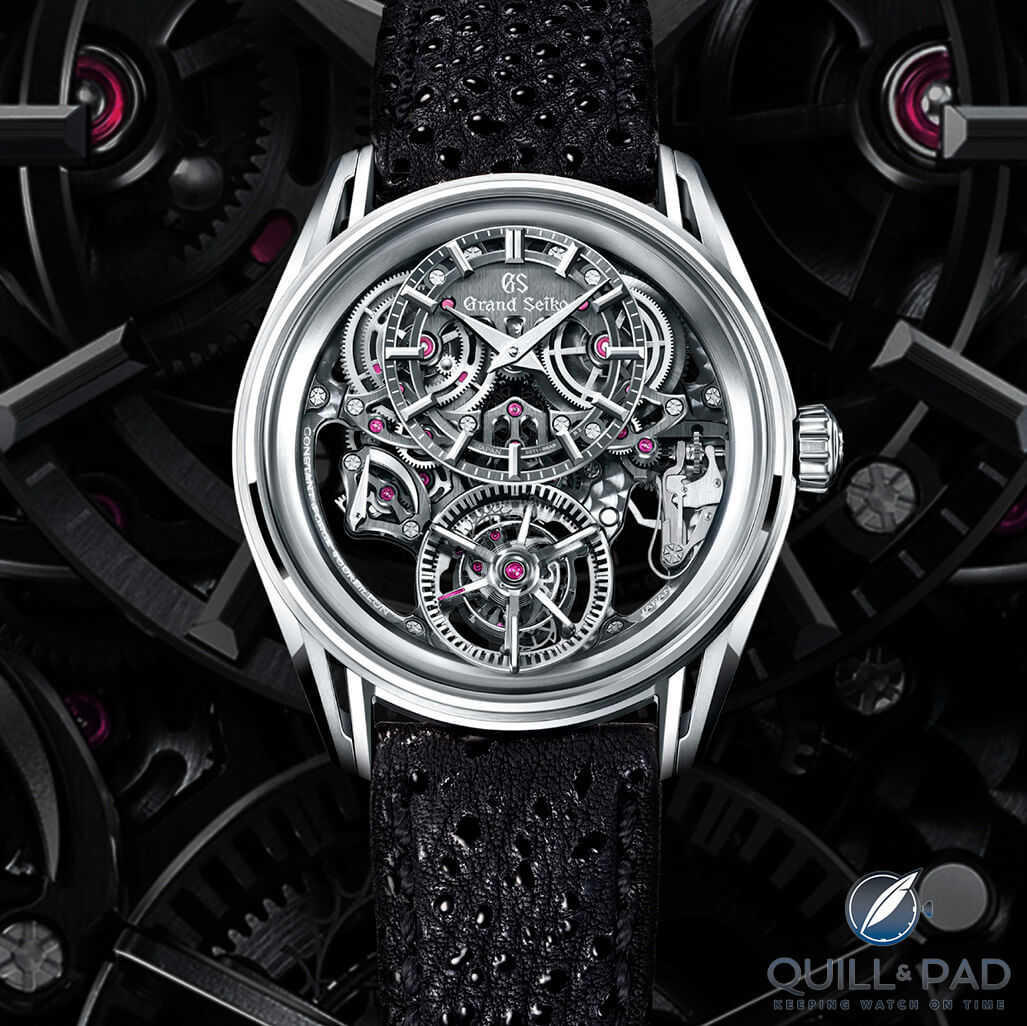
Grand Seiko Kodo Constant Force Tourbillon
It’s for that reason that when I first laid eyes on Grand Seiko’s new Kodo Constant Force Tourbillon the song wriggled free from the recesses of my brain and sprang to my lips: I felt like what I was seeing was surely a dream, but it was 100 percent real.
The culmination of years of work, and two years after the introduction of the T0 Concept movement, the Kodo Constant Force Tourbillon is the mechanical smorgasbord that I have been itching for from Grand Seiko. And now it has arrived.
Grand Seiko Kodo Constant Force Tourbillon SLGT003
The change in perception of the song “I Dreamed A Dream” could be analogous to how the wider opinions of Grand Seiko shifted when the T0 was first announced two years ago. What was previously thought of as a reserved, traditional, and cautious brand was shattered when the incredible concept movement came out, showcasing the exact same Japanese dedication to craft and its perfection that we’ve always known, but applied in a way that shook the entire watch industry. But what was just a concept movement before, and what could have been passed off as an engineering exercise, now has become a reality.
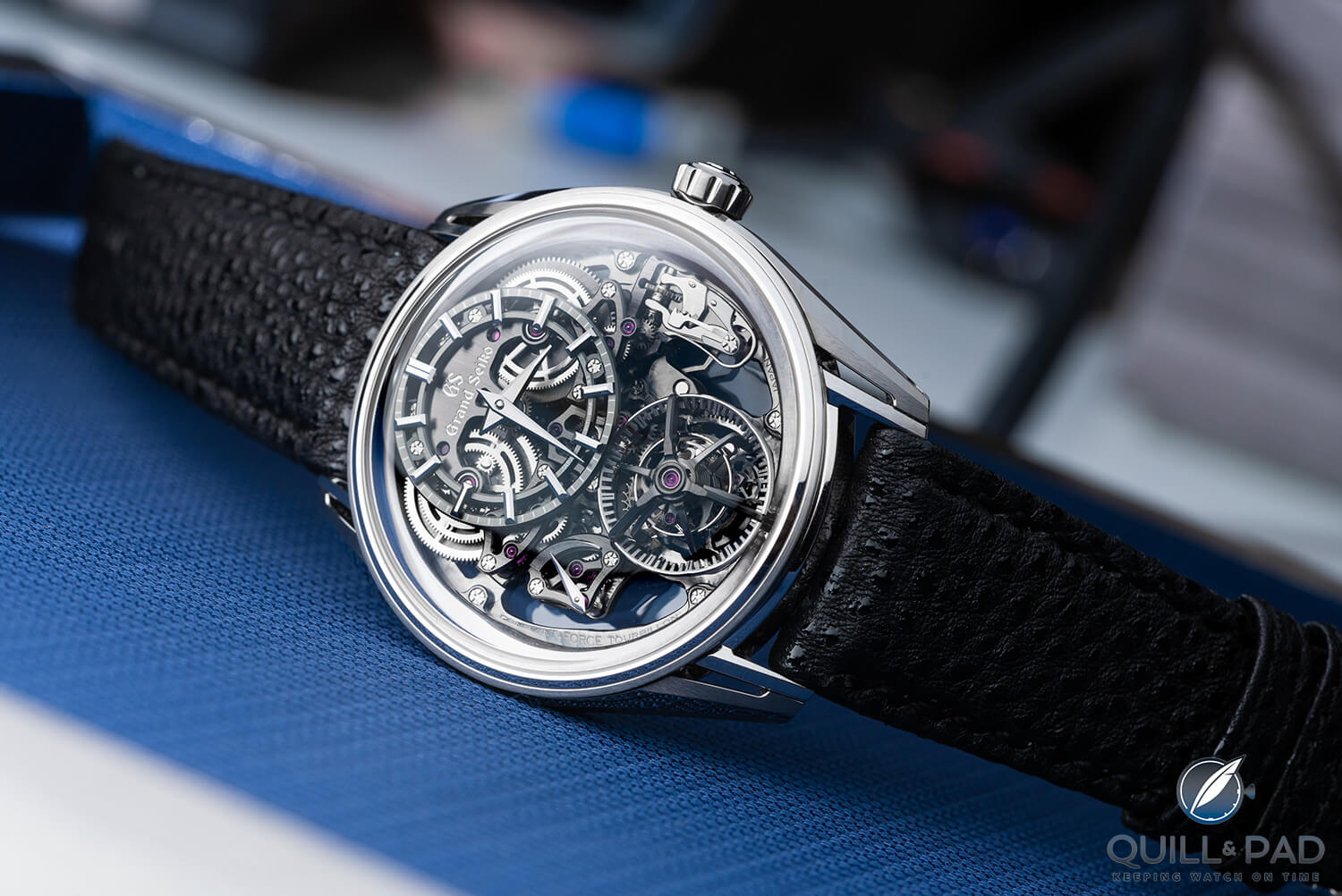
Grand Seiko Kodo Constant Force Tourbillon (photo courtesy Alex Teuscher)
The Kodo Constant Force Tourbillon is a full manifestation of the precision excellence one finds at Grand Seiko, along with a tacit indication that there should be no doubt in any aficionado’s mind whether Grand Seiko belongs in the top tier of haute horology. I said as much when I wrote about the T0, but with a full watch now in existence the truth is undeniable.
The Kodo (which means “heartbeat” in Japanese) represents a lot of firsts for Grand Seiko, but the two most obvious ones are what you see right away: it is a skeleton watch (never seen before in Grand Seiko) with a bold tourbillon at 6 o’clock (multiple firsts rolled into one). The display is a combination of subdued greys from the variously finished components and bright red from some of the 44 jewels helping to keep the movement precise.
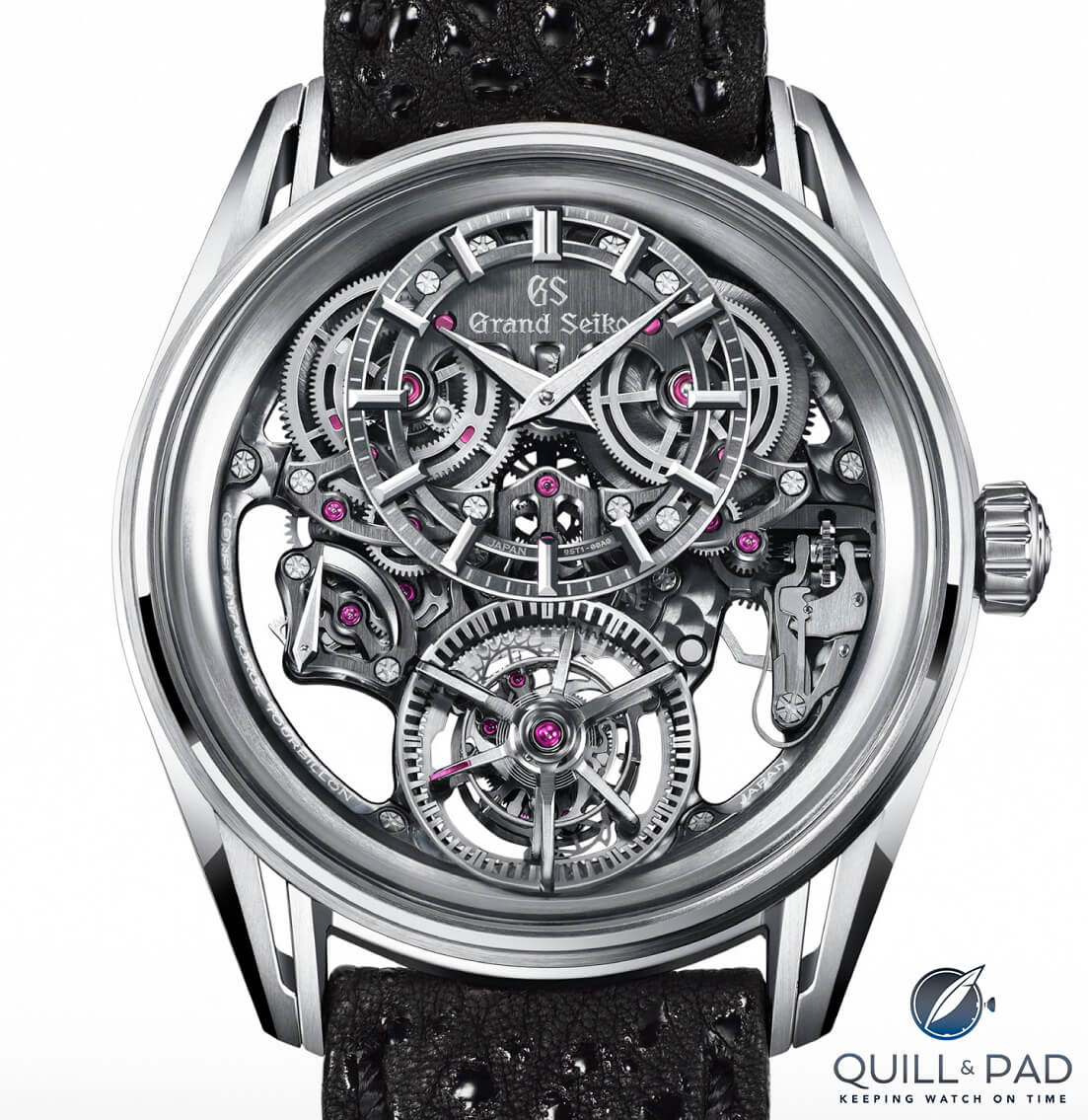
Grand Seiko Kodo Constant Force Tourbillon
On the left side of the “dial” is a power reserve indication nestled into the corner between the large tourbillon ring and the off-center time display dial at 12 o’clock, with the rest of the area inside the case showcasing the precision horology that Grand Seiko is known for but in a decidedly new way. Grand Seiko has always been aesthetically focused on the gradation of shadows and playing with light, exploring the texture found in shadows, and the Kodo Constant Force Tourbillon is no different.
Instead of playing with the subtle textures of an irregularly scalloped dial meant to resemble stone or a snow-swept field, the varieties of finishes applied to the different levels of parts and the ability for light to pass down into the movement create new ways for shadows to affect each component, establishing visual movement depending on how you look at it.
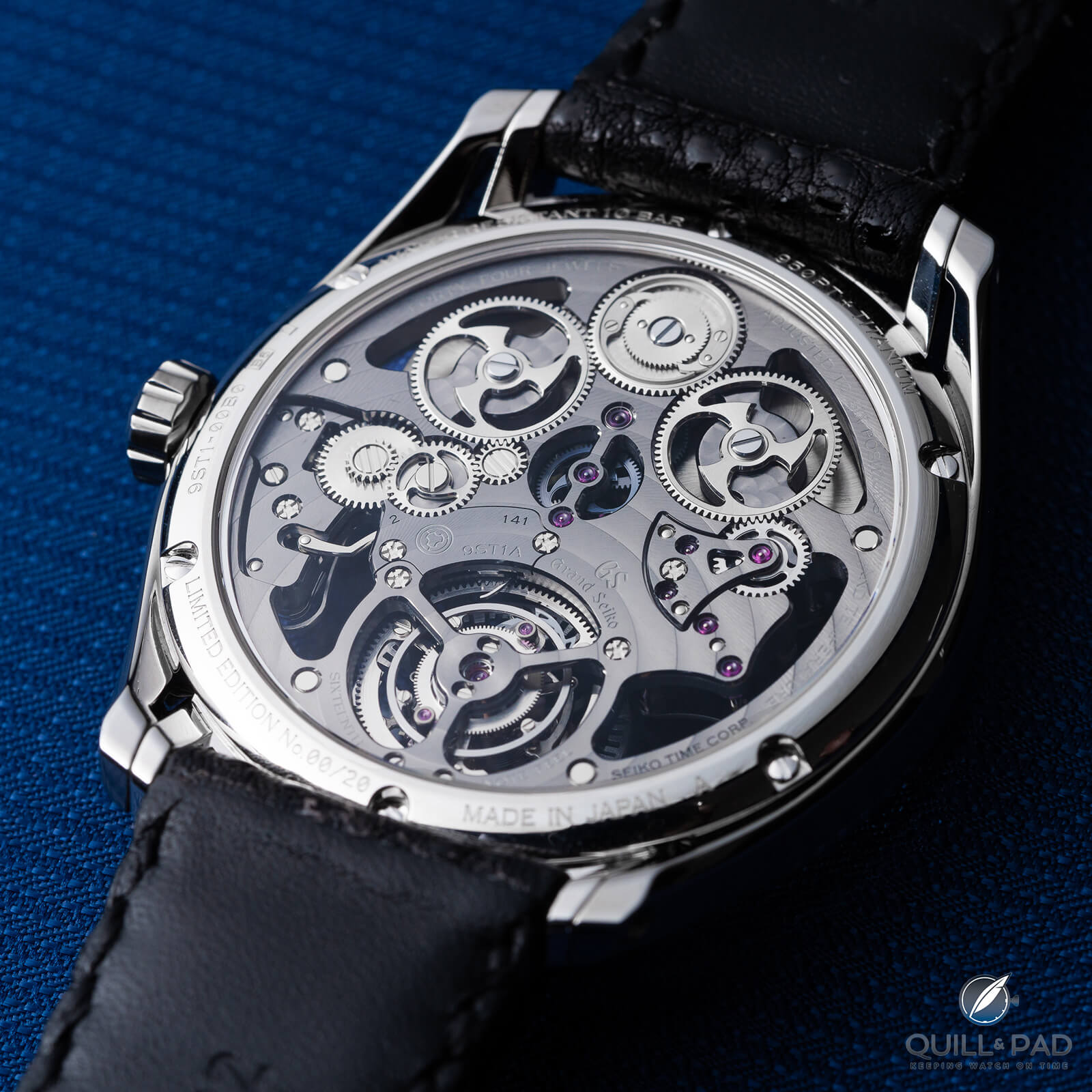
Back of the Grand Seiko Kodo Constant Force Tourbillon (photo courtesy Alex Teuscher)
The details of the Kodo Constant Force Tourbillon read like the press release for an avant-garde indie brand looking to make a splash, not the venerated Japanese king of restrained horology.
Everything makes sense
But as Grand Seiko does, the Kodo Constant Force Tourbillon is a carefully planned and considered masterpiece with the primary goal of practical precision, which becomes obvious in many of the technical details and is only superseded by the humbly approached desire to arrive in Geneva with style. The latter was a success with Grand Seiko’s first appearance at Watches and Wonders, but what about the former?
Grand Seiko had spent eight years realizing the constant force tourbillon and accompanying movement of the T0 announced in the fall of 2020. The company required another two years to completely revamp that movement for use in the new Kodo Constant Force Tourbillon. The movement was reworked, changing about 90 percent of the 340 components from the original concept mostly just so that it could fit in the 43.8 mm case.

Grand Seiko Kodo Constant Force Tourbillon tourbillon cage
The tourbillon is the heart of innovation within the watch and it’s easy to see why. It all begins with the constant force mechanism, which is located within the tourbillon cage and on the same axis to eliminate as much torque loss as possible. Every time a gear meshes with another gear, the resulting friction and change in direction results in a loss of torque. Add up the number of gears in the going train and there are a lot of chances to lose power delivery to the balance wheel if the energy was coming only from the mainspring.

Grand Seiko Kodo Constant Force Tourbillon tourbillon cage diagram
Putting the constant force spring directly on the axis of rotation not only bypasses the mainspring and going train, it also allows the spring to be a nearly direct source of consistent power. It also removes the variable of side loading, which is where the power source imparts a twisting force on the inner cage, which causes an increase of friction through the slight binding action as the cage twists out of the way. This is a relatively minor motion in the bigger scheme of things, but when consistency and efficiency are the goals anything to maximize power delivery over longer timescales cannot be underestimated.
The design had the main goal of keeping the balance amplitude high, a necessity for maintaining isochronism, so with the main oscillation being driven by the constant force spring immediately below the cage it maintains a consistent delivery of power. It recharges once a second after four full oscillations (eight semi-oscillations) to provide that regular force and is assisted by the highly precise MEMS escape wheel that was carefully designed to have a tiny step on the end of each arm to help retain lubrication over the service interval.
High tech and tradition
But it gets better: nearly every gear in the going train has been made using MEMS technology (“Micro Electro Mechanical Systems,” the proprietary Seiko method to create high-detail, microscopic components by building a component layer by layer that is comparable to LIGA), which means that not only is the power delivery to the balance as efficient and low friction as possible, so is the energy getting to the constant force mechanism.
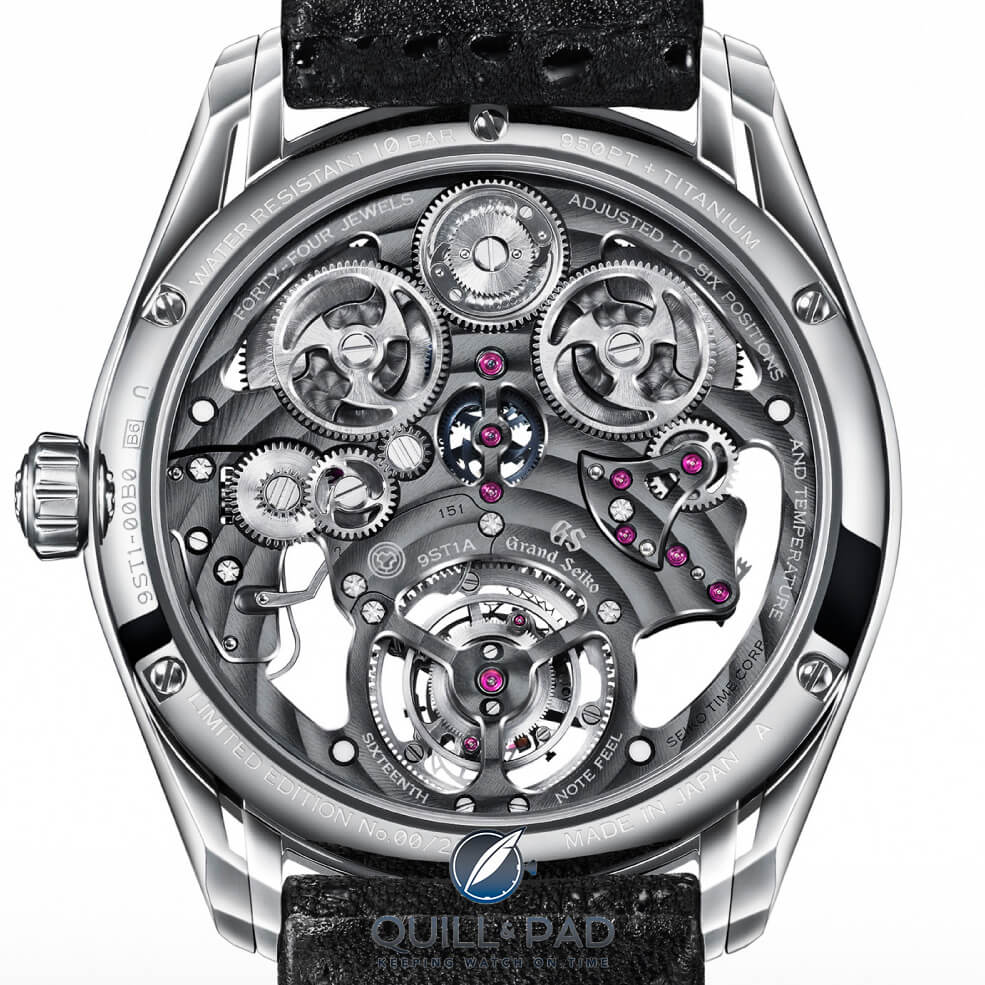
Back of the Grand Seiko Kodo Constant Force Tourbillon
The MEMS technology creates components so precise that typically there is no reason to modify them, but Grand Seiko went a step further and engaged in some light beveling and decoration, leaving no proverbial stone unturned.
And while the movement is clearly a creation of progress within Grand Seiko, it has hallmarks of a traditional movement such as an indication of seconds attached to the tourbillon cage, except that in this case is it a ruby jewel mounted directly in the arm providing a sliver of color. That color goes well with the almost playful sound of the Kodo (yes, I said sound).
The 4 Hz tourbillon combined with the constant force mechanism (which is both a Grand Seiko and world first) has a peculiar trait that one can only hear and not directly see. The eight semi-oscillations of the balance combine with the once-a-second constant force escapement creating a rhythm that I find very catchy. The balance and constant force play off each other to sound like a drummer keeping pace during the intro to an R&B song.

Grand Seiko Kodo Constant Force Tourbillon (photo courtesy Alex Teuscher)
Regardless of whether the movement is made using high-tech tools and sounds like a song on the radio, the skeletonizing and finishing are all very classic and clean, and the subdued colors allow the wearer to have something that is bold while being still a bit under the radar. That is until you take into consideration the four-millimeter-high box sapphire crystal and combination polished titanium and platinum case.
The combination, which sees an outer case and bezel made of Grand Seiko’s Brilliant Hard Titanium and inner case and interior bezel made of 950 platinum, provides all sorts of surfaces to drool over. Using a very traditional and difficult technique called Zaratsu polishing, both the titanium and the platinum are carefully brought to an incredibly high level of polish that shines as bright as a gemstone. As time consuming as that technique is, performing it on 950 platinum (a difficult material to bring to a high polish) for a perfect result requires 6-10 times as much labor.
Craft
Striving for perfection is often the Japanese way when it comes to notoriously difficult tasks, so we shouldn’t be surprised that Grand Seiko puts that effort into polishing the case after it spent all that time designing and engineering the movement, reworking it to fit in a smaller case, and finishing it to such a high degree. This attention to detail and craft can be found throughout the movement, from the custom screw head designs (which mimic the shape of the tourbillon cage arms) to the wheels that are meant to resemble whirlpools (the literal English translation of the French word “tourbillon”) but in a classic Japanese aesthetic.
This even extends to the strap, which is no mere calfskin strap but a carefully prepared bit of textured leather upon which numerous layers of Urushi lacquer are applied to make it both visually arresting and durable. It’s little things like those that go hand in hand with the incredible engineering to make it a truly standout piece for Grand Seiko.
It paid off too: with only 20 pieces planned to be produced and interest from all over the world, Grand Seiko didn’t have a hard time finding people who would want it. Those lucky (and very well-heeled) buyers will be getting a fantastic timepiece, not just a gimmick. The Kodo Constant Force Tourbillon excels in supreme reliability and accuracy, matching or bettering C.O.S.C. chronometer numbers thanks to Grand Seiko’s intense new standard of 48 hours of testing in every position, taking 34 days to certify the watch as finished and ready for its new owner.
No longer is Credor the only home for Grand Seiko haute horology, with the Kodo Constant Force Tourbillon the brand has finally stepped into the limelight to showcase what it can do and to end all debate whether it could match or surpass what the Swiss or Germans can do.
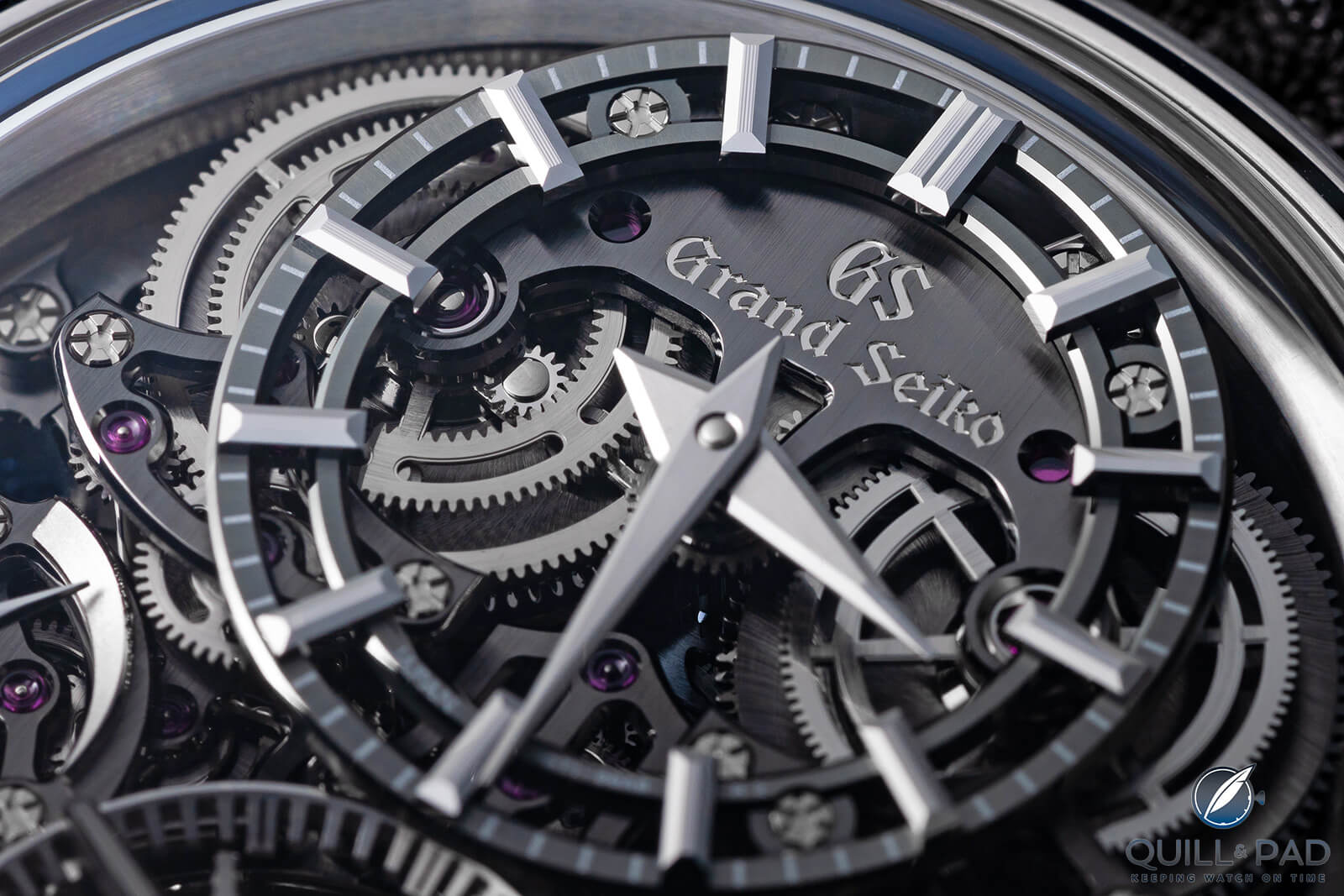
Grand Seiko Kodo Constant Force Tourbillon dial detail (photo courtesy Alex Teuscher)
My only regret is that Grand Seiko chose to forgo the awesome and unique blued steel hands and the gold ring for seconds around the tourbillon that were seen on the T0, opting for a more subdued display. But then again, it wouldn’t be Grand Seiko if it started throwing in tons of contrasting colors.
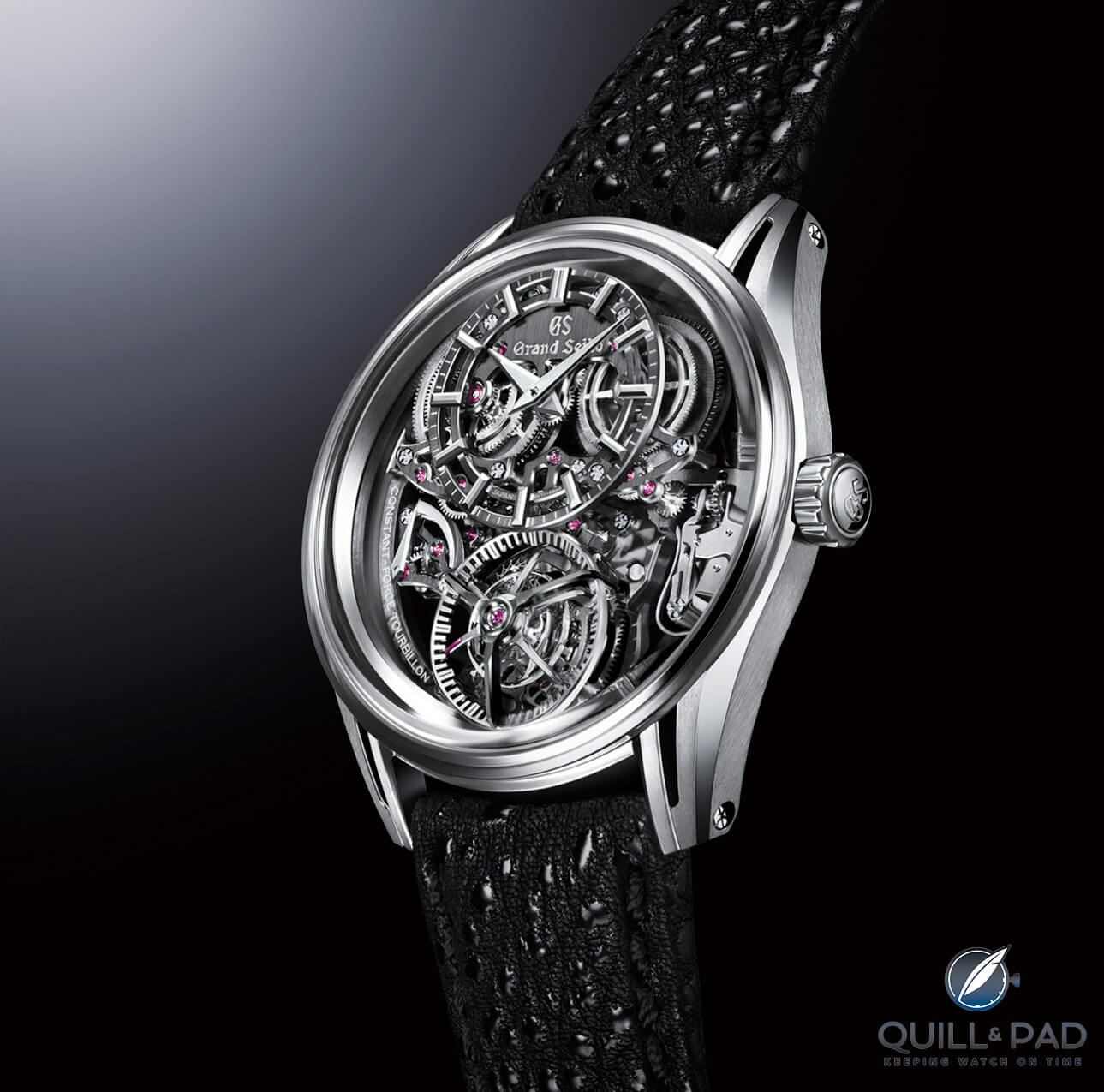
Grand Seiko Kodo Constant Force Tourbillon
Watches and Wonders Geneva 2022 was a spectacular place to launch the Kodo Constant Force Tourbillon and it cemented Grand Seiko’s spot among the best in haute horology that you find in those hallowed halls. Now my main goal is to get some one-on-one time with the Kodo Constant Force Tourbillon before they all disappear into private collections never to be seen again!
So before that happens, let’s break it down!
- Wowza Factor * 9.8 As a longtime fan of Grand Seiko who absolutely loves avant-garde independent brands, this watch wowed me more than most could. It was a long time coming!
- Late Night Lust Appeal * 98» 961.052m/s2 If it isn’t the incredible tourbillon or the constant force escapement added into that tourbillon, then it’s the culmination of over 65 years of horological expertise being flexed that keeps me up at night!
- M.G.R. * 70.5 Grand Seiko is known for precision and practicality, so combining that with this type of movement makes it a massively geeky piece of mechanics!
- Added-Functionitis * Mild Like we’ve come to expect from some of the coolest watches, this doesn’t rely on massive complications to make it awesome, but perfectly reasoned ones, so you will only need some children’s strength Gotta-HAVE-That cream for the horological awesomeness in this piece!
- Ouch Outline * 11 Rolling your ankle while running through the woods! Roots, you gotta watch out for roots! It doesn’t matter how often you run, all it takes is one misstep and your ankle will be smarting for a week while you walk with a limp. Still, I’d gladly take the risk every day if I was running to put on the Kodo Constant Force Tourbillon!
- Mermaid Moment * I’ve Been Waiting For You! Sometimes we are waiting for something we don’t know will ever come, and the day it arrives you are overcome with emotion and the only thing you can do is say, “I do!”
- Awesome Total * 980 Start with the alloy number of the platinum in the hybrid case (950) and add in the hours of power reserve while under constant force (50), then subtract the number of pieces in the limited edition (20) and the result will be an appropriately epic and timely awesome total!
For more information, please visit www.grand-seiko.com.
Quick Facts Grand Seiko Kodo Constant Force Tourbillon SLGT003
Case: 43.8 x 12.9 mm, hybrid platinum 950 and Brilliant Hard Titanium
Movement: manually wound Caliber 9ST1 with co-axial constant force one-minute tourbillon, 72-hour power reserve (50 hours of constant force), 28,800 vph/4 Hz frequency
Functions: hours, minutes, seconds; power reserve
Limitation: 20 pieces
Price: €370,000
You may also enjoy:
Grand Seiko T0 Constant Force Tourbillon: I Couldn’t Believe My Eyes
6 Super-Cool Yet Relatively Affordable Timepieces From Watches And Wonders 2022
Leave a Reply
Want to join the discussion?Feel free to contribute!





















































There was never any doubt that GS could do this.
Remember they were banned from Swiss accuracy competitions because they kept winning! 😁
I’m not quite sure what it adds to their portfolio though. It’s a bit like a jazz great recording a classical piece to impress those who don’t like jazz.
The, in my eyes, crucial question: Does it hack? Why all the efforts if you can’t set the watch precisely? A comment to the Mr Munchow, a high amplitude does not improve isochronism. Ok, semantics but on your level of horological knowledge and on the standards your writing exhibits, you may consider rephrasing. MEMS is not a proprietary Seiko technology.
Thanks for the nice article on an outstanding watch.
While a higher amplitude does not improve isochronism in a perfect balance Spezi, in the real world no balance is perfect. A higher amplitude provides more inertia which provides a more stable i.e., more isochronic, rate as it is less affected by shocks.
MEMS (Micro Electro Mechanical System) is proprietary Seiko technology, it was developed by Seiko’s semiconductor division.
Regards, Ian
As you said, a high amplitude provides in the real world a more stable rate, lower escapement error the main reason I believe as a perfect compensation of the escapement error with decreasing amplitude does not exist. Anyway, semantics; high amplitude is simply a good thing and too often not achieved, or not stable in tourbillons (I dare say so from own experience), kudos to Seiko for addressing it with there co-axial remontoir. Btw, if one imagine their new half-coaxial-half-anchor-escapement in it, that’ll complete top the development, just dreaming…
To the crucial question, yes it does hack. It is also 100m water resistant if you want to take it for a swim.
As you point out MEMS is a generic term and not specific to Seiko. They do use a proprietary technique that was developed from their semiconductor division as Ian mentions. I believe the technique is actually LIGA based from discussions I had with staff at the factory. It would be better to state “…using MEMS technology (“Micro Electro Mechanical Systems,” utilizing a proprietary Seiko method…”
It does hack, great! That’s what I find elevates any tourbillon. Thanks for your shared view on MEMS. Seiko holds many patents, I do not follow their IP. They may have proprietary techniques or parts, but MEMS is such a generic term covering so many techniques outside the watchmaking that one shouldn’t link it to one producer. Sure, there are the specific developments of key players which deserve mention. My comment wasn’t neither to diminish achievements of Seiko or criticise Ian’s excellent writing. Just to someone who holds such high standards I dare to comment.
Looking forward to the owner’s review by GaryG.
Gran ejercicio técnico. Lejos de las lineas de diseño características de la marca. Hubiera preferido que este esfuerzo se hubiera empleado en un Repetidor de minutos en unas cotas de caja mas comedidas. Muy subjetivamente ya me aburren tantos tourbillones por tantas marcas.
En relojería se considera al mecanismo que hace funcionar a un reloj repetidor como un de sistema muy complejo, mucho más que el tourbillon, aunque por su vistosidad sea este último quien se haya ganado la fama de cúspide en complicación de movimientos. Lo demuestra el hecho de que tourbillones hay bastantes marcas que los hacen, pero relojes de repetición minutera sólo son capaces de fabricarlos unas pocas manufacturas.
Gostaria de representar GRAND SEIKO em Minas Gerais
All the Best Our Seiko I Hope Three Hand Watch Ready Happy 2022*